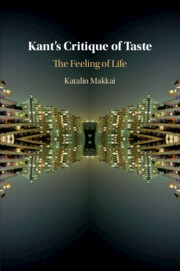Book contents
- Kant’s Critique of Taste
- Kant’s Critique of Taste
- Copyright page
- Contents
- Acknowledgments
- Note on Citations
- Introduction
- Chapter 1 The Art of Judgment
- Chapter 2 Communication and Animation in the Judgment of Taste
- Chapter 3 Subjectivity and Recognition in the Judgment of Taste
- Chapter 4 Modes of Attunement
- Chapter 5 Aesthetic Liking
- Bibliography
- Index
Chapter 2 - Communication and Animation in the Judgment of Taste
Published online by Cambridge University Press: 07 April 2021
- Kant’s Critique of Taste
- Kant’s Critique of Taste
- Copyright page
- Contents
- Acknowledgments
- Note on Citations
- Introduction
- Chapter 1 The Art of Judgment
- Chapter 2 Communication and Animation in the Judgment of Taste
- Chapter 3 Subjectivity and Recognition in the Judgment of Taste
- Chapter 4 Modes of Attunement
- Chapter 5 Aesthetic Liking
- Bibliography
- Index
Summary
This chapter is centered upon the section of the “Critique of Aesthetic Judgment” that Kant calls the “key” to the critique of taste and in which he elaborates the judgment of taste in terms that are striking yet scant, familiar yet elusive: a “state of mind” of “free play” of the cognitive powers, in which they are in “harmony” or “attunement” and are mutually “animated,” and in which their “subjective relation” corresponds to a “subjective condition” of cognition. I propose that a key to Kant’s thought is to be found in the notion of “universal communicability,” which this section introduces. The sense of “communication” on which it depends is, I argue, to be understood robustly, as having to do with the imparting of something to someone. I then argue that the judgment of taste turns on an experience of wanting to render communicable, or explore and articulate, one’s encounter with the extra-factual aesthetic character of the object. My interpretation reorients the role and significance of pleasure, and of feeling more generally, in the judgment of taste. The pleasure of the judgment of taste is in the object and in one’s state of mind, which the object is felt to awaken.
Keywords
- Type
- Chapter
- Information
- Kant's Critique of TasteThe Feeling of Life, pp. 70 - 102Publisher: Cambridge University PressPrint publication year: 2021

